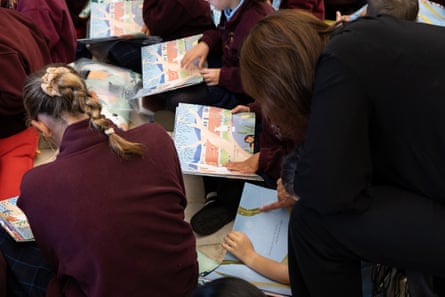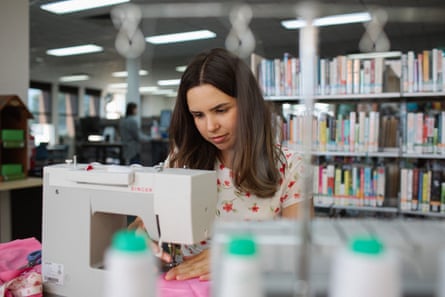
A woman walks briskly through the sensor doors, a tote bag of paperbacks over her right shoulder. An elderly man sits at a communal table, his eyebrows furrowed as he works his way through a crossword. Behind him, a teenage girl stares intently at her laptop, techno music thumping softly from her headphones.
It’s an unseasonably warm winter’s day in Sydney’s inner west and yet I’ve managed to find myself indoors. Distancing myself from the herds of cafe-goers and pub-crawlers, I’ve decided to spend my afternoon in the public library. It’s a place I’ve recently rediscovered, on a personal mission to find cost-free entertainment.
Although it’s been a while between visits, the public library is not foreign to me.
 View image in fullscreenChildren participate in a story-time event at the National Library of Australia. Photograph: Australian Library and Information Association
View image in fullscreenChildren participate in a story-time event at the National Library of Australia. Photograph: Australian Library and Information Association
As a child, I spent school holidays at library-run kids’ programs, lazing on bean bags and partaking in DIY crafts. As a preteen, I’d spend hours with my head buried in books, lapping up teenage romance novels. As a high schooler, I’d sieve through shelves of CDs in pursuit of the latest pop anthems to upload to my pink iPod mini.
Now in an inflation-induced financial pinch, my appreciation takes the form of physically seeking out books. When I was younger, I would choose books based on school reading challenges or whatever series was the talk of the playground. Now I rarely come with specific titles in mind to borrow.
Instead, I revel in the journey and not the destination. I walk up and down aisles, sliding paperbacks off shelves to examine them more closely. I study blurbs, sit cross-legged in cosy corners and skim-read opening chapters until I’m left with a stack of books to borrow.
-
Sign up for the fun stuff with our rundown of must-reads, pop culture and tips for the weekend, every Saturday morning
Cameron Morley, the head of public services at the State Library of New South Wales, says I am not alone.
“There’s often a spike in library usage during tough economic times,” Morley says. “People realise that the library is an easy way where you can make a saving. They’re spaces where you can do your own thing and have no pressure to spend money.”
This pattern is playing out in real time – in August, the State Library of NSW regularly recorded more than 3,000 visitors a day; 110% of pre-pandemic visitation levels.
Library borrowing, especially digital resources, has been on an upward trajectory since the pandemic too, Morley says.
Digital collections have grown to include audiobooks, comics, magazines, newspapers and even streaming services. Australians made use of 42.2m physical and digital collection items in 2021-22, up from 39.2m in the year before the pandemic, according to the Australian public libraries statistical report, released in March this year.
skip past newsletter promotion
Sign up to Saved for Later
Free newsletter
Catch up on the fun stuff with Guardian Australia’s culture and lifestyle rundown of pop culture, trends and tips
Enter your email address Enter your email address Sign upPrivacy Notice: Newsletters may contain info about charities, online ads, and content funded by outside parties. For more information see our Privacy Policy. We use Google reCaptcha to protect our website and the Google Privacy Policy and Terms of Service apply.
after newsletter promotion
 View image in fullscreenDepending on your local branch, you may be able to borrow musical instruments, bike repair kits or even sewing machines. Photograph: Australian Library and Information Association
View image in fullscreenDepending on your local branch, you may be able to borrow musical instruments, bike repair kits or even sewing machines. Photograph: Australian Library and Information Association
And it’s not just books or records being borrowed. Morley says public libraries have also expanded the types of items they make available. Depending on your local branch, you may be able to take home musical instruments such as keyboards, ukuleles and guitars; retro, game-equipped consoles like an Atari Flashback or PlayStation Classic; dog toys; DIY bike repair kits fitted with pumps and tools; and even seeds to plant in the garden (you return them post-harvest).
Increasingly, Australian library-goers are also borrowing space itself. Many public libraries now offer private study spaces and meeting rooms, which Australians booked for more than 500,000 hours last year. More affordable than a commercial co-working space, libraries are becoming a place people turn to when working from home is not working for them.
The business of silence: is there a hidden cost to noise cancelling?Read more
In fact, libraries are transforming into “community hubs” to work, play or access outreach services – at no cost to visitors. The Australian Library and Information Association says forthcoming data from Public Libraries Victoria’s annual survey suggests that, with Covid restrictions now over, participation in free library programs increased by 95% this year.
Public Libraries Victoria recorded 1.7 million people attended school holiday programs, story-time sessions for young children, social activities for older people and other free programs. In Melbourne’s mortgage belt – including areas such as Wyndham, Melton, Hume and Casey – program participation growth was even higher, with numbers up by 105% in the past 12 months.
Despite being a paperback enthusiast who returned to the library mostly to browse the aisles, I’m excited to explore the library’s lesser-known, community and digital resources now too.
In an era marked by cost-of-living pressures, public libraries offer financial and emotional refuge: a place where time does not have to mean money.



